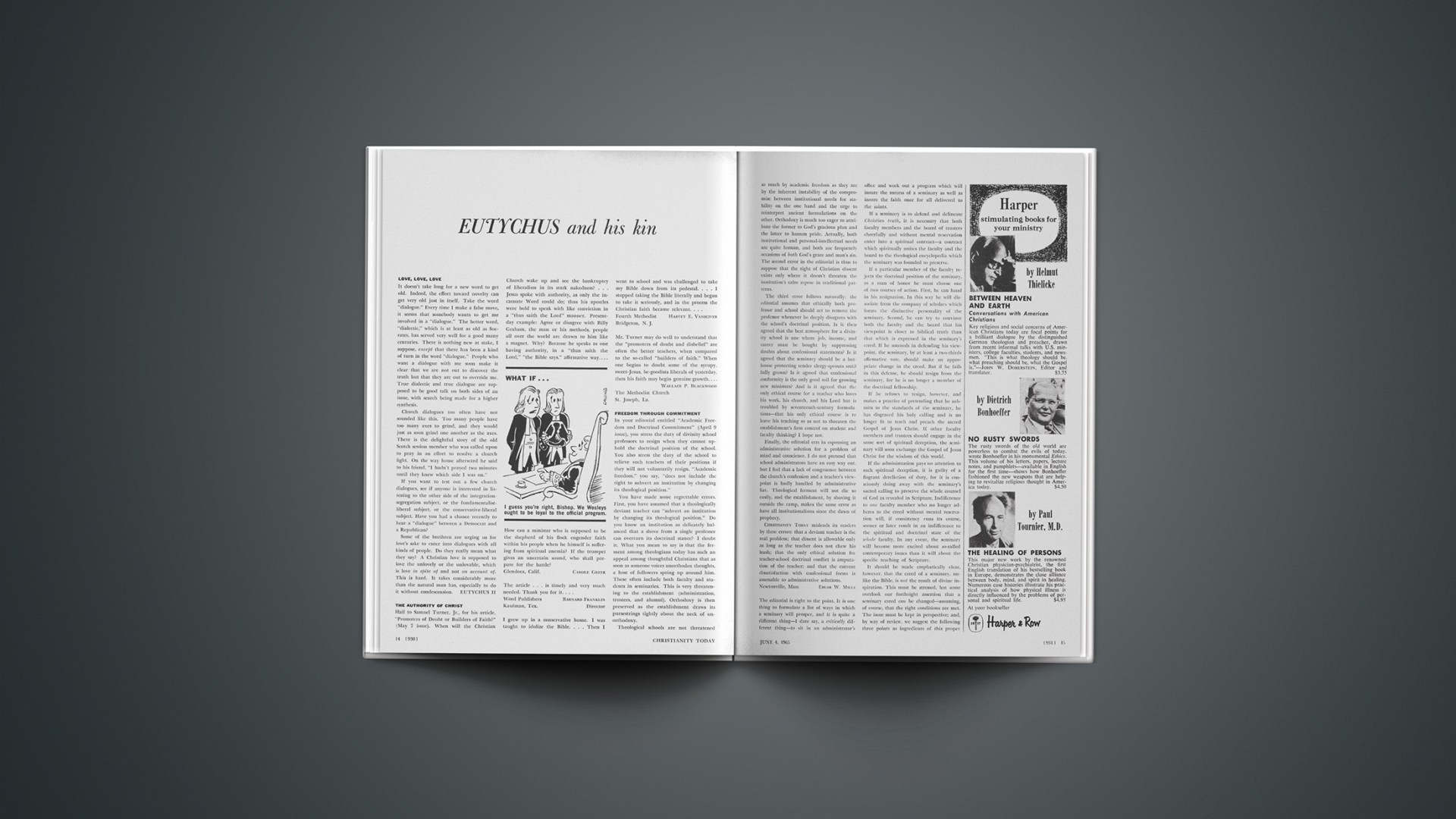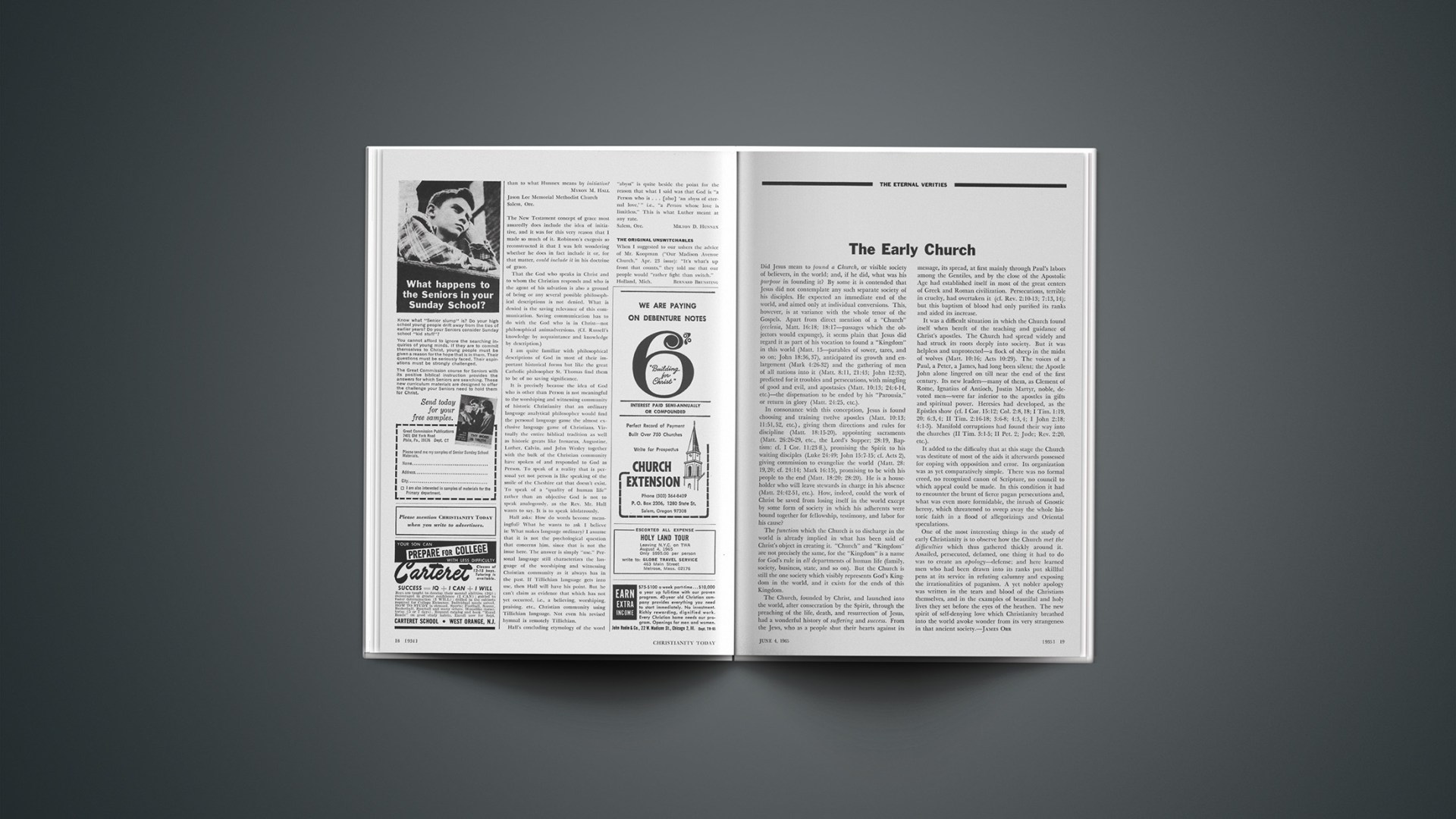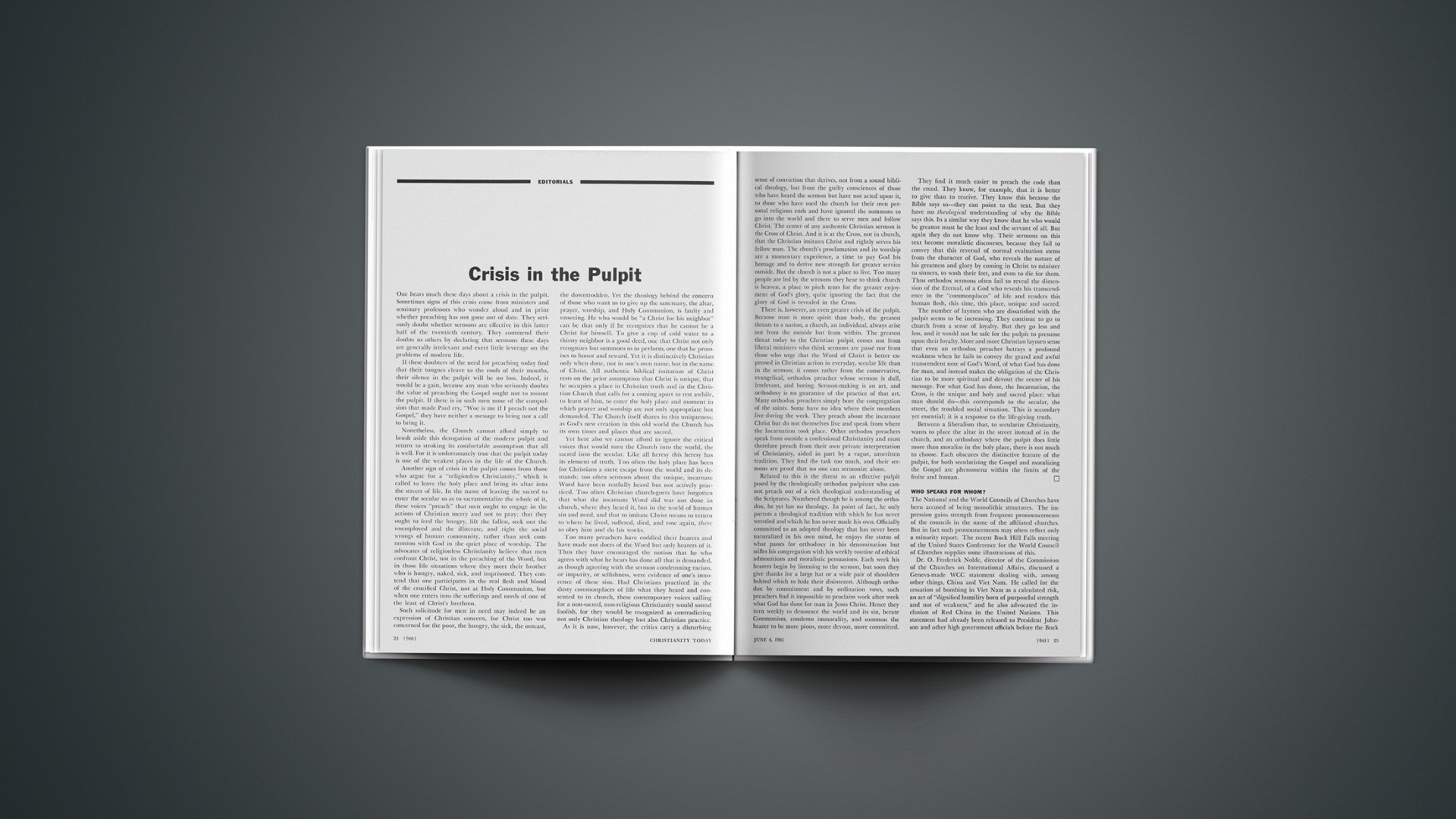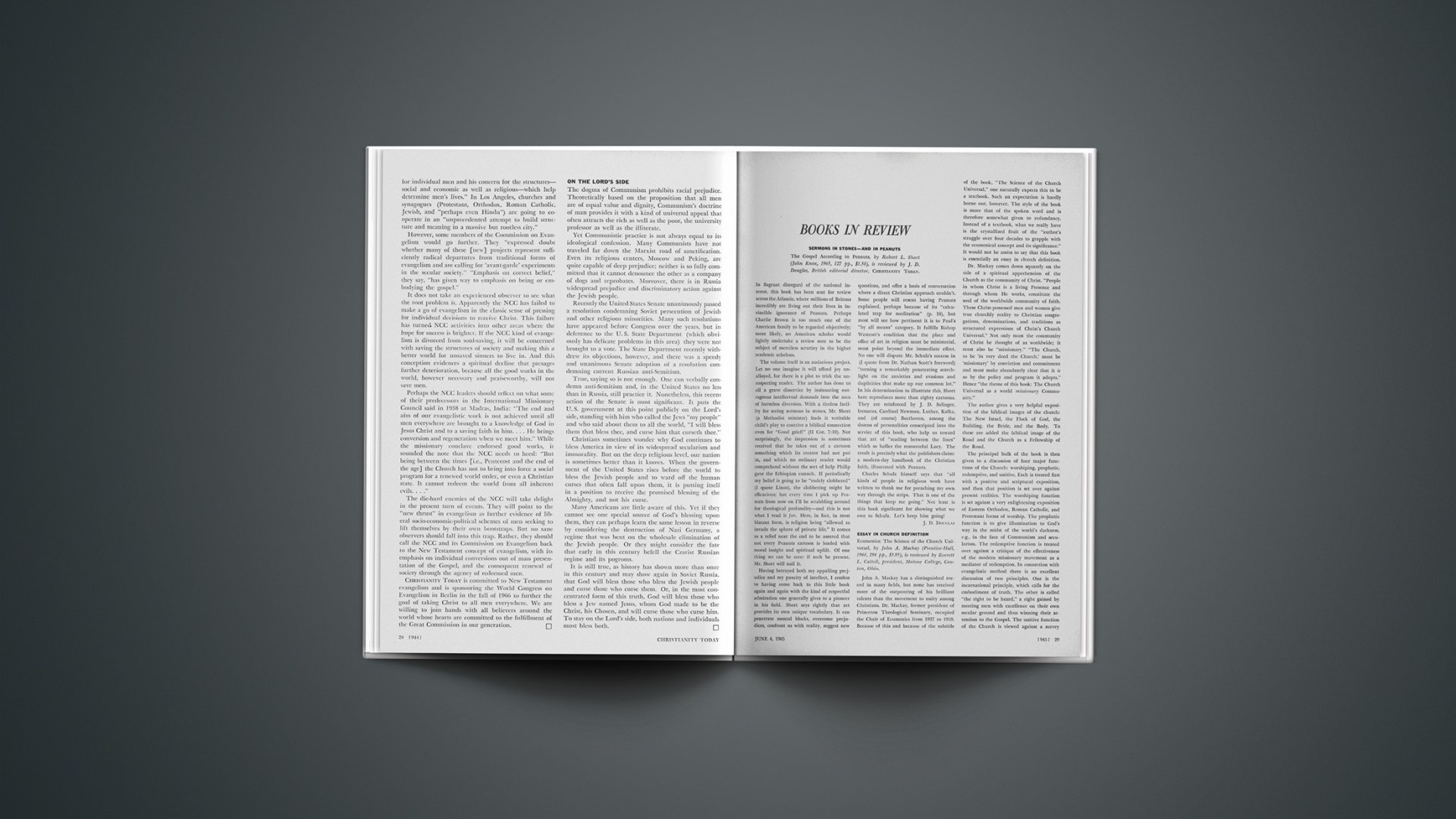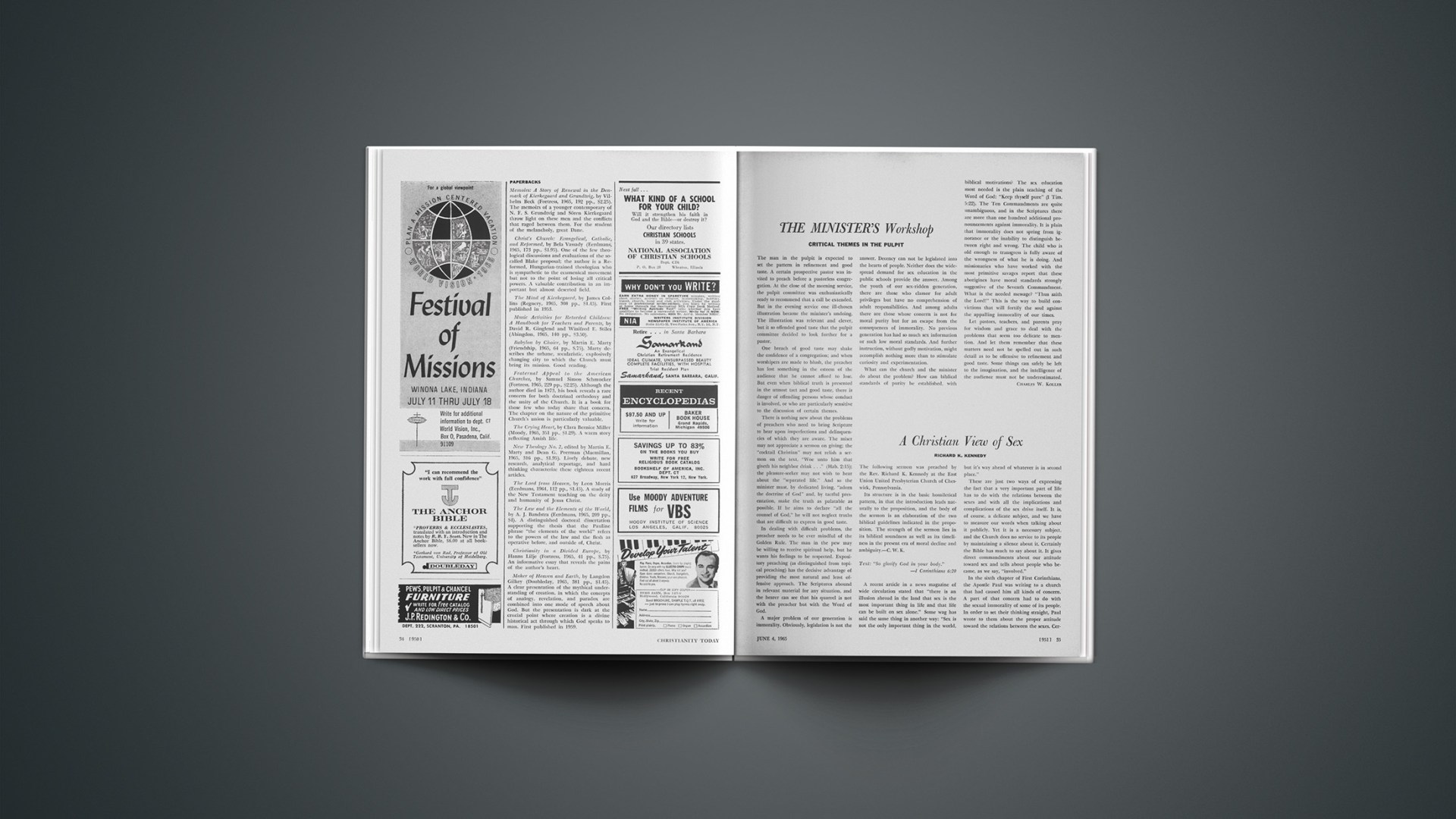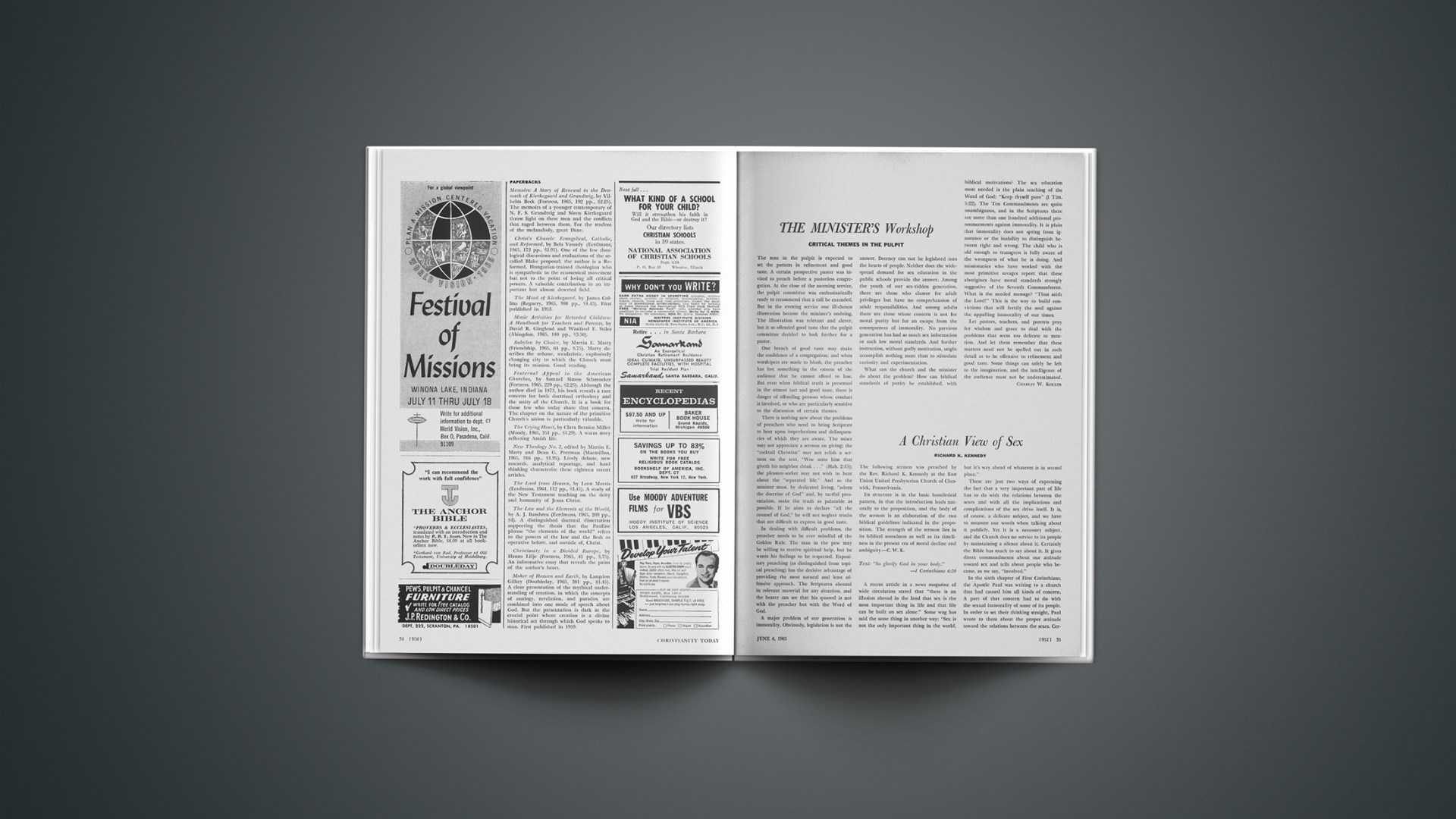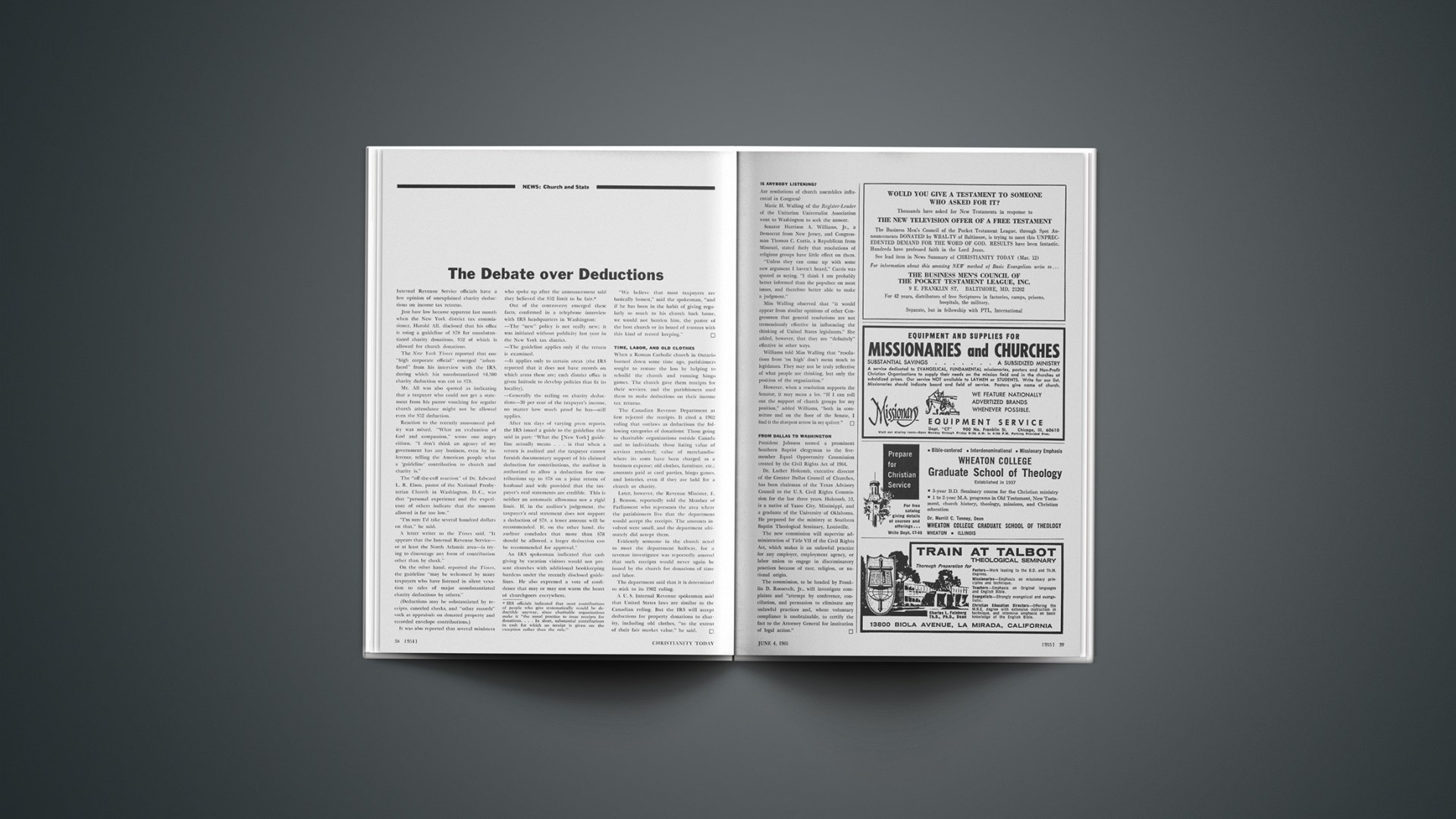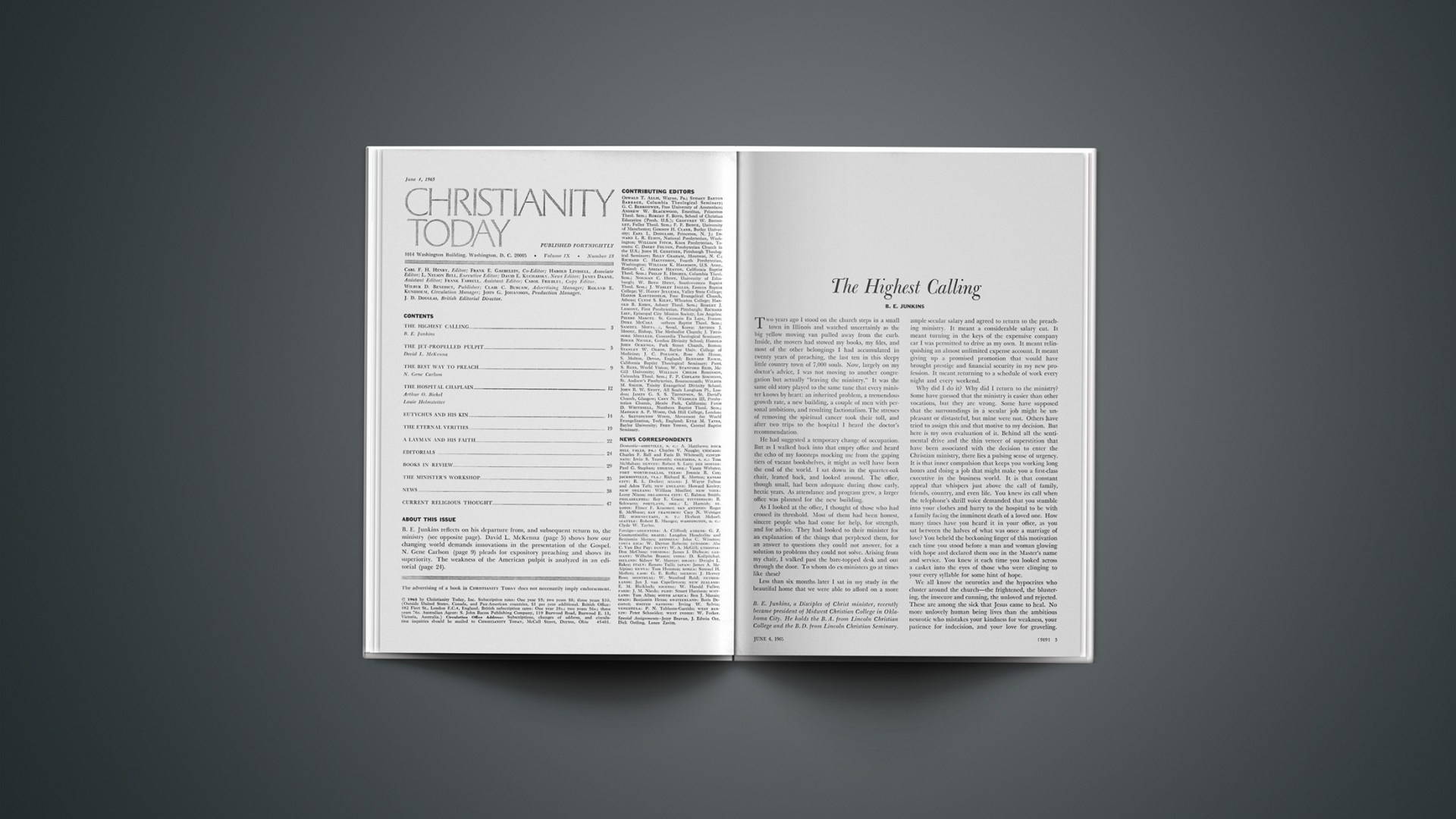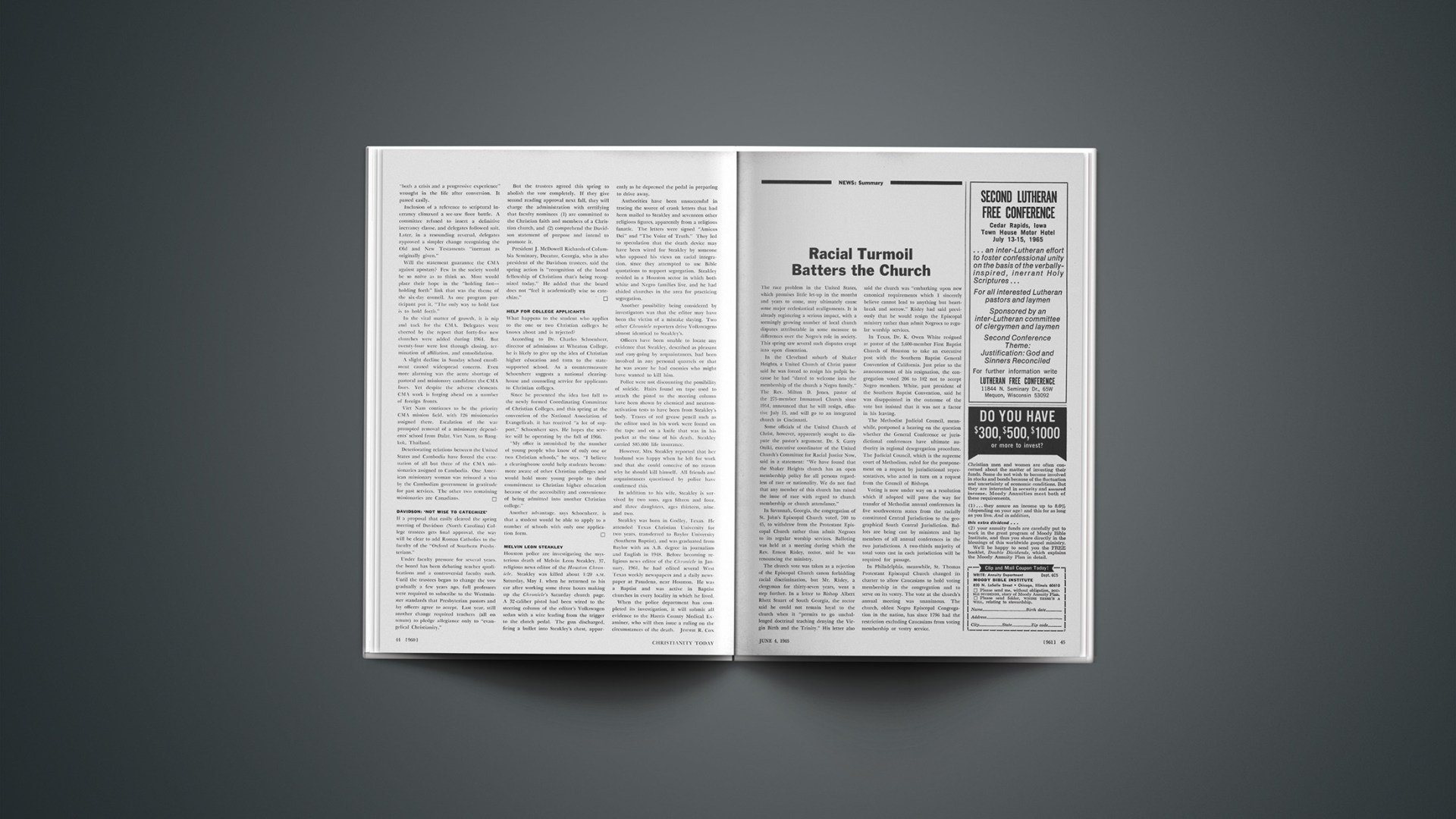LOVE, LOVE, LOVE
It doesn’t take long for a new word to get old. Indeed, the effort toward novelty can get very old just in itself. Take the word “dialogue.” Every time I make a false move, it seems that somebody wants to get me involved in a “dialogue.” The better word, “dialectic,” which is at least as old as Socrates, has served very well for a good many centuries. There is nothing new at stake, I suppose, except that there has been a kind of turn in the word “dialogue.” People who want a dialogue with me soon make it clear that we are not out to discover the truth but that they are out to override me. True dialectic and true dialogue are supposed to be good talk on both sides of an issue, with search being made for a higher synthesis.
Church dialogues too often have not sounded like this. Too many people have too many axes to grind, and they would just as soon grind one another as the axes. There is the delightful story of the old Scotch session member who was called upon to pray in an effort to resolve a church fight. On the way home afterward he said to his friend, “I hadn’t prayed two minutes until they knew which side I was on.”
If you want to test out a few church dialogues, see if anyone is interested in listening to the other side of the integration-segregation subject, or the fundamentalist-liberal subject, or the conservative-liberal subject. Have you had a chance recently to hear a “dialogue” between a Democrat and a Republican?
Some of the brethren are urging us for love’s sake to enter into dialogues with all kinds of people. Do they really mean what they say? A Christian love is supposed to love the unlovely or the unlovable, which is love in spite of and not on account of. This is hard. It takes considerably more than the natural man has, especially to do it without condescension.
THE AUTHORITY OF CHRIST
Hail to Samuel Turner, Jr., for his article, “Promoters of Doubt or Builders of Faith?” (May 7 issue). When will the Christian Church wake up and see the bankruptcy of liberalism in its stark nakedness?… Jesus spoke with authority, as only the incarnate Word could do; thus his apostles were bold to speak with like conviction in a “thus saith the Lord” manner. Present-day example: Agree or disagree with Billy Graham, the man or his methods, people all over the world are drawn to him like a magnet. Why? Because he speaks as one having authority, in a “thus saith the Lord,” “the Bible says,” affirmative way.… How can a minister who is supposed to be the shepherd of his flock engender faith within his people when he himself is suffering from spiritual anemia? If the trumpet gives an uncertain sound, who shall prepare for the battle?
Glendora, Calif.
The article … is timely and very much needed. Thank you for it.…
Word Publishers
Kaufman, Tex.
Director
I grew up in a conservative home. I was taught to idolize the Bible.… Then I went to school and was challenged to take my Bible down from its pedestal.… I stopped taking the Bible literally and began to take it seriously, and in the process the Christian faith became relevant.…
Fourth Methodist
Bridgeton, N.J.
Mr. Turner may do well to understand that the “promoters of doubt and disbelief” are often the better teachers, when compared to the so-called “builders of faith.” When one begins to doubt some of the syrupy, sweet-Jesus, be-goodists liberals of yesterday, then his faith may begin genuine growth.…
The Methodist Church
St. Joseph, La.
FREEDOM THROUGH COMMITMENT
In your editorial entitled “Academic Freedom and Doctrinal Commitment” (April 9 issue), you stress the duty of divinity school professors to resign when they cannot uphold the doctrinal position of the school. You also stress the duty of the school to relieve such teachers of their positions if they will not voluntarily resign. “Academic freedom,” you say, “does not include the right to subvert an institution by changing its theological position.”
You have made some regrettable errors. First, you have assumed that a theologically deviant teacher can “subvert an institution by changing its theological position.” Do you know an institution so delicately balanced that a shove from a single professor can overturn its doctrinal stance? I doubt it. What you mean to say is that the ferment among theologians today has such an appeal among thoughtful Christians that as soon as someone voices unorthodox thoughts, a host of followers spring up around him. These often include both faculty and students in seminaries. This is very threatening to the establishment (administration, trustees, and alumni). Orthodoxy is then preserved as the establishment draws its pursestrings tightly about the neck of unorthodoxy.
Theological schools are not threatened so much by academic freedom as they are by the inherent instability of the compromise between institutional needs for stability on the one hand and the urge to reinterpret ancient formulations on the other. Orthodoxy is much too eager to attribute the former to God’s gracious plan and the latter to human pride. Actually, both institutional and personal-intellectual needs are quite human, and both are frequently occasions of both God’s grace and man’s sin. The second error in the editorial is thus to suppose that the right of Christian dissent exists only where it doesn’t threaten the institution’s calm repose in traditional patterns.
The third error follows naturally: the editorial assumes that ethically both professor and school should act to remove the professor whenever he deeply disagrees with the school’s doctrinal position. Is it then agreed that the best atmosphere for a divinity school is one where job, income, and career must be bought by suppressing doubts about confessional statements? Is it agreed that the seminary should be a hothouse protecting tender clergy-sprouts until fully grown? Is it agreed that confessional conformity is the only good soil for growing new ministers? And is it agreed that the only ethical course for a teacher who loves his work, his church, and his Lord but is troubled by seventeenth-century formulations—that his only ethical course is to leave his teaching so as not to threaten the establishment’s firm control on student and faculty thinking? I hope not.
Finally, the editorial errs in espousing an administrative solution for a problem of mind and conscience. I do not pretend that school administrators have an easy way out, but I feel that a lack of congruence between the church’s confession and a teacher’s viewpoint is badly handled by administrative fiat. Theological ferment will not die so easily, and the establishment, by shoving it outside the camp, makes the same error as have all institutionalisms since the dawn of prophecy.
CHRISTIANITY TODAY misleads its readers by these errors: that a deviant teacher is the real problem; that dissent is allowable only as long as the teacher does not chew his leash; that the only ethical solution for teacher-school doctrinal conflict is amputation of the teacher; and that the current dissatisfaction with confessional forms is amenable to administrative solutions. Newtonville, Mass.
The editorial is right to the point. It is one thing to formulate a list of ways in which a seminary will prosper, and it is quite a different thing—I dare say, a critically different thing—to sit in an administrator’s office and work out a program which will insure the success of a seminary as well as insure the faith once for all delivered to the saints.
If a seminary is to defend and delineate Christian truth, it is necessary that both faculty members and the board of trustees cheerfully and without mental reservation enter into a spiritual contract—a contract which spiritually unites the faculty and the board to the theological encyclopedia which the seminary was founded to preserve.
If a particular member of the faculty rejects the doctrinal position of the seminary, as a man of honor he must choose one of two courses of action. First, he can hand in his resignation. In this way he will dissociate from the company of scholars which forms the distinctive personality of the seminary. Second, he can try to convince both the faculty and the board that his viewpoint is closer to biblical truth than that which is expressed in the seminary’s creed. If he succeeds in defending his viewpoint, the seminary, by at least a two-thirds affirmative vote, should make an appropriate change in the creed. But if he fails in this defense, he should resign from the seminary, for he is no longer a member of the doctrinal fellowship.
If he refuses to resign, however, and makes a practice of pretending that he submits to the standards of the seminary, he has disgraced his holy calling and is no longer fit to teach and preach the sacred Gospel of Jesus Christ. If other faculty members and trustees should engage in the same sort of spiritual deception, the seminary will soon exchange the Gospel of Jesus Christ for the wisdom of this world.
If the administration pays no attention to such spiritual deception, it is guilty of a flagrant dereliction of duty, for it is consciously doing away with the seminary’s sacred calling to preserve the whole counsel of God as revealed in Scripture. Indifference to one faculty member who no longer adheres to the creed without mental reservation will, if consistency runs its course, sooner or later result in an indifference to the spiritual and doctrinal state of the whole faculty. In any event, the seminary will become more excited about so-called contemporary issues than it will about the specific teaching of Scripture.
It should be made emphatically clear, however, that the creed of a seminary, unlike the Bible, is not the result of divine inspiration. This must be stressed, lest some overlook our forthright assertion that a seminary creed can be changed—assuming, of course, that the right conditions are met. The issue must be kept in perspective; and, by way of review, we suggest the following three points as ingredients of this proper perspective: (a) as long as the creed of a seminary takes a certain form, both faculty members and the board of trustees have a moral obligation to uphold the creed in this form; (b) academic liberty to investigate all points of view is granted—for example, the professor of theology has complete freedom (or better, he is academically required) to offer a course in the major religions of the world, even though the major doctrines of other religions do not harmonize with the creed of the seminary; (c) if a member of the faculty or trustees is unable to support the creed of the seminary in its existing form, he should either put forth an effort to convince his colleagues that a specific change in the creed will bring the creed into closer conformity with the infallible truths of the Bible, or he ought to have sufficient character and integrity to resign from the seminary.
All too often it is assumed that if a seminary takes its statement of faith seriously, the right to conduct research into new ideas, let alone the privilege of dealing with exegetical and theological problems in the classroom, will be endangered. The exact opposite is the case—providing, however, that we are dealing with conditions that exist (or should exist) in a mature seminary, and not with the conditions that exist in a seminary which has degenerated into a cult. It can be safely observed that whenever an entire family of faculty and trustees freely commits itself to what it believes is an accurate, creedal summary of the Gospel, all suspicion of individuals within the seminary instantly vanishes. Although complete freedom to think and to write exists, the defense and delineation of the Gospel of Jesus Christ continue to serve as the true rallying points.
Most of the above material should be self-evident, for if it is true that God has entrusted the Church with a propositional account of his will for sinful humanity (the source of this account being the Holy Bible), how could a seminary fulfill its calling unless the personnel who formed the seminary—faculty and trustees alike—were dedicated to each and every truth contained in revelation?
Prof. of Ethics and Philosophy of Religion
Fuller Theological Seminary
Pasadena, Calif.
THE SELMA STORY
So many accounts [of the march to Montgomery] have been totally one-sided and have tended to lump everybody in Alabama into the one category of “violent extremist” that it has been hard on the people here to keep from being angered by them. I think our national understanding of any given local area and our mutual spirit of fellowship and oneness greatly suffer under this kind of journalism.
As I know you realize, despite all of our shortcomings in this area and especially despite the … deplorable incidents which have occurred, there is another side to the story.
Let me thank you for your endeavor to present elements of both sides of the Selma story (News, Apr. 9 issue) accurately and to be thoroughly fair in your appraisal.
Howard College
Birmingham, Ala.
Dean of Religion
Surely it is not too much to ask that our dedicated Northern brother ministers leave judgment and condemnation to the Father of us all. Surely we are not over-stepping our bounds by asking that the cup of bitterness not be pressed on us by those whose prayers we most need. The bitterest pain of all is that inflicted by dedicated, good, but uninformed men in the same service of the same Lord and Master of all.…
Notasulga. Ala.
HYMNALS ARE NOT YET TILLICHIAN
Milton Hunnex, who is a member of this congregation, has raised a significant point for the ongoing Honest to God exchanges when he points out that Bishop John Robinson makes little room for “the notion of God’s initiative” (Mar. 26 issue). Professor Hunnex contends that the bishop’s use of Tillich’s definition of God as “ground of being” has introduced a concept which has its origin outside the Christian community at large. He also asserts that it does not coincide with the God to whom the body of Christian believers respond in joy and thanksgiving.
My question is this: Has not Professor Hunnex himself illustrated the very problem with which Tillich and Robinson are concerned—how the Gospel is to be communicated? Let me illustrate my question by pointing out that the word initiative, for which Professor Hunnex contends, is certainly not a New Testament term. Nor is it the normal word used by the Christian community to describe God’s action for man. That word is grace.
Doubtless, as a professor of philosophy, Dr. Hunnex finds the concept of “initiative” congenial to his own thought patterns. I will not deny him the privilege and right to use the word. But to insist that Robinson has turned theology into anthropology because the bishop’s statements are “about the quality of human life” rather than about “the mighty act of God” is certainly to ignore the valid use of analogical thought patterns in both homiletical and theological endeavors.
How do the words—New Testament or otherwise—in which the Gospel is expressed become meaningful to the ones to whom they are addressed? Professor Hunnex, for all his implicit exposition of the common language point of view, has not yet answered that! Rather, he has illustrated that there is a language that is common to certain theologians and philosophers.
Indeed, the closing sentence of his article raises the whole difficulty in a most acute form. There Professor Hunnex approvingly quotes the words of Luther that God is “an abyss of eternal love.” But the word abyss has been derived from the Greek of the LXX where it translates the Hebrew tehom, the primeval waters of creation (Gen. 1:2, “deep” in AV and RSV). Is not the “deep” much closer to what Tillich calls groundthan to what Hunnex means by initiative?
Jason Lee Memorial Methodist Church
Salem, Ore.
The New Testament concept of grace most assuredly does include the idea of initiative, and it was for this very reason that I made so much of it. Robinson’s exegesis so reconstructed it that I was left wondering whether he does in fact include it or, for that matter, could include it in his doctrine of grace.
That the God who speaks in Christ and to whom the Christian responds and who is the agent of his salvation is also a ground of being or any several possible philosophical descriptions is not denied. What is denied is the saving relevance of this communication. Saving communication has to do with the God who is in Christ—not philosophical animadversions. (Cf. Russell’s knowledge by acquaintance and knowledge by description.)
I am quite familiar with philosophical descriptions of God in most of their important historical forms but like the great Catholic philosopher St. Thomas find them to be of no saving significance.
It is precisely because the idea of God who is other than Person is not meaningful to the worshiping and witnessing community of historic Christianity that an ordinary language analytical philosopher would find the personal language game the almost exclusive language game of Christians. Virtually the entire biblical tradition as well as historic greats like Irenaeus, Augustine, Luther, Calvin, and John Wesley together with the bulk of the Christian community have spoken of and responded to God as Person. To speak of a reality that is personal yet not person is like speaking of the smile of the Cheshire cat that doesn’t exist. To speak of a “quality of human life” rather than an objective God is not to speak analogously, as the Rev. Mr. Hall wants to say. It is to speak idolatrously.
Hall asks: How do words become meaningful? What he wants to ask I believe is: What makes language ordinary? I assume that it is not the psychological question that concerns him, since that is not the issue here. The answer is simply “use.” Personal language still characterizes the language of the worshiping and witnessing Christian community as it always has in the past. If Tillichian language gets into use, then Hall will have his point. But he can’t claim as evidence that which has not yet occurred, i.e., a believing, worshiping, praising, etc., Christian community using Tillichian language. Not even his revised hymnal is remotely Tillichian.
Hall’s concluding etymology of the word “abyss” is quite beside the point for the reason that what I said was that God is “a Person who is … [also] ‘an abyss of eternal love,’ ” i.e., “a Person whose love is limitless.” This is what Luther meant at any rate.
Salem, Ore.
THE ORIGINAL UNSWITCHABLES
When I suggested to our ushers the advice of Mr. Koopman (“Our Madison Avenue Church,” Apr. 23 issue): “It’s what’s up front that counts,” they told me that our people would “rather fight than switch.”
Holland, Mich.
